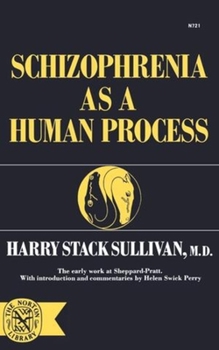Schizophrenia as a Human Process
Select Format
Select Condition 
Book Overview
Amongst clinicians, Sullivan is probably best known for his early work with schizophrenics at the Sheppard and Enoch Pratt Hospital in Towson, Maryland. Yet this fame has been largely legendary, since the only full record of this work is found scattered through various professional journals and monographs published more than twenty-five years ago and in an unpublished book written in the thirties, Personal Psychopathology. In this present book of selected papers, the author has tried to reconstruct this work by bringing together what he considers to be the most crucial of these papers.
Format:Paperback
Language:English
ISBN:0393007219
ISBN13:9780393007213
Release Date:January 1974
Publisher:W. W. Norton & Company
Length:404 Pages
Weight:0.83 lbs.
Dimensions:1.0" x 5.0" x 8.0"
Customer Reviews
1 rating
If there, where was I?
Published by Thriftbooks.com User , 22 years ago
This book is far too technical to have fugue-ing in the index. It doesn't even have confabulation. Sullivan's book, The Interpersonal Theory of Psychiatry (I gave my copy to my son last year, so I'm not seeing it now) might be a better source for functional definitions of the terms that I should be thinking about when I run my thinking into America's experience in Nam. I was hoping that, looking at descriptions of schizophrenia, I could find some technical description of aggravation, like: try grabbing a machine gun and shooting it straight up in the air ~ it works the same way.Due to a 150 day drop when I ended my tour as a draftee in Nam, I only served 19 months in the U.S. Army. SCHIZOPHRENIA AS A HUMAN PROCESS by Harry Stack Sullivan contains a paper, "Psychiatric Training as a Prerequisite to Psychoanalytic Practice" originally reprinted from Amer. J. Psychiatry (1934-35), in which Stack attempted to convince the American Psychiatric Association to require psychiatric training in a mental hospital to contribute to "the professional competence of the psychoanalyst." (p. 309). In order to learn anything, "I personally favor heartily the requirement that the young physician make many written statements as to his view of this and that. Suave, quick-minded people often conceal in their spoken comments misapprehensions that they entertain. Once their views are recorded, deficiencies in their formulations are readily pointed out. Intensive criticism . . . coupled with some clinical demonstrations of how things really are done and of what has significance in the relationship of a competent psychiatrist and his patient, would vastly abbreviate the staggering amount of time it takes the average intern to find a clue to the nature of psychiatric therapy. I have said often that it takes 18 months residence . . . Moreover, adequate supervision would remedy immediately one grave development that now involves many young physicians who enter the psychiatric field. I refer to the damnable business of learning how to `get away with it' without really knowing what is going on, or caring." (pp. 317-8).






